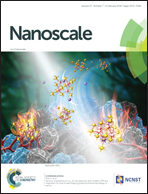Phase engineering of seamless heterophase homojunctions with co-existing 3R and 2H phases in WS2 monolayers†
Abstract
Self-organized semiconductor–semiconductor heterostructures (3R–2H) that coexist in atomically thin 2D monolayers forming homojunctions are of great importance for next-generation nanoelectronics and optoelectronics applications. Herein, we investigated the defect controlled growth of heterogeneous electronic structure within a single domain of monolayer WS2 to enable in-plane homojunctions consisting of alternate 2H semiconducting and 3R semiconducting phases of WS2. X-ray photoelectron, Raman, and photoluminescence spectroscopy along with fluorescence and Kelvin probe force microscopy imaging confirm the formation of homojunctions, enabling a direct correlation between chemical heterogeneity and electronic heterostructure in the atomically thin WS2 monolayer. Quantitative analysis of phase fractions shows 59% stable 2H phase and 41% metastable 3R phase estimated over WS2 flakes of different sizes. Time-resolved fluorescence lifetime imaging confirms distinct contrast between 2H and 3R phases with two distinct lifetimes of 3.2 ns and 1.1 ns, respectively. Kelvin probe force microscopy imaging revealed an abrupt change in the contact potential difference with a depletion width of ∼2.5 μm, capturing a difference in work function of ∼40 meV across the homojunction. Further, the thermal stability of coexisting phases and their temperature dependent optical behavior show a distinct difference among 2H and 3R phases. The investigated aspects of the controlled in plane growth of coexisting phases with seamless homojunctions, their properties, and their thermal stability will enable the development of nanoscale devices that are free from issues of lattice mismatch and grain boundaries.



 Please wait while we load your content...
Please wait while we load your content...